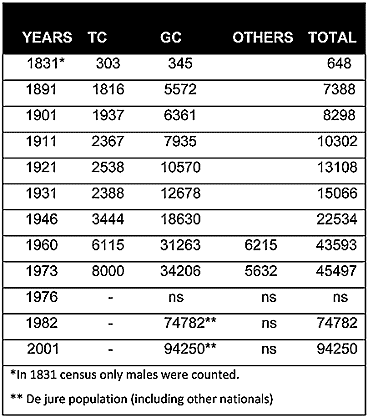

From the Ottoman period the town was inhabited by both Muslims and Christians. Greek Cypriots always constituted the majority of the population. As can be seen from the Ottoman census of 1831, Greek Cypriots comprised almost 53% of the population. This percentage increased significantly during the British period, rising to 75% in 1891. The same percentage prevailed during the first half of the 20th century. It slightly declined to 71% in 1960 when the island gained its independence. It is important to note that in 1960 there were also 5,296 British and 916 persons of other ethnic and religious backgrounds (Armenians, Maronites, and Latins, etc.) residing in the town, making it a very cosmopolitan place.
Displacement:
No one was displaced from the town during the 1950s emergency years. However, during the intercommunal strife of 1963-64, many Turkish Cypriots from nearby villages or suburbs fled their homes and sought refuge in the Turkish Cypriot quarter of the town. For instance, Richard Patrick claims that, after fighting broke out in Limassol on 9 February 1964, about 400 Turkish Cypriots, almost 7% of the Turkish Cypriot population of Limassol, were forced from their homes and became displaced within the Turkish Cypriot quarter. He also recorded that in 1971 there were still 217 displaced Turkish Cypriots residing in the Turkish Cypriot neighborhood of the city. Patrick also notes that the Turkish Cypriot quarter of the town was not demarcated by fortifications as in Nicosia(074), Larnaca(361) or Paphos(329). He explains that “although there was fighting in and around the Turk-Cypriot quarter, the establishment of an effective Political Liaison Committee made the demarcation of an armed cease-fire line unnecessary to contain and prevent further inter-communal violence.” However, the same author also claims that the British Bases played a huge role in keeping the peace: “Part of the explanation for the relative inter-communal calmness for Limassol might be found in these British connections. The British UNFICYP commander responsible for Limassol Region may have been able to imply that local violence would have had an adverse effect on the amount of economic support that the Limassol communities received from Akrotiri” (1976, 307).
It should be noted, however, that although the Turkish quarter of Limassol was not an enclave strictly speaking, it was guarded by around 950 Turkish Cypriot Fighters who, for reasons of safety, did not wear their uniforms in the streets. They had their own administration, including a radio station and weekly “official” newspaper, indicating that the Turkish quarter was run much like enclaves in the rest of the island (Fehmi 2003, 104-106).
On 20 July 1974, in response to the Turkish military offensive in the island, fierce fighting began in and around the Turkish quarter of the town. The quarter was attacked from all sides, and Turkish Cypriot Fighters returned fire. After six hours and 36 deaths, the Turkish Cypriot Fighters surrendered, and all men of fighting age were taken as prisoners of war. Almost 2,700 men were held for 100 days, first in the Limassol stadium and then in empty school buildings, before the prisoner exchange in which the men were released and sent to the north. While the men were being held prisoner, their families attempted to escape to the north either by purchasing transit—an often dangerous enterprise—or by taking refuge in the Akrotiri British Sovereign Base Area. In January 1975, those who had taken refuge in Akrotiri were finally sent to the north via Turkey. This involved sending them to Adana by air, from where they were sent by boat at intervals back to north Cyprus. Most of the displaced Turkish Cypriots from Limassol later settled in the city of Kyrenia/Girne(236) and in its vicinity, though many also were resettled in the Famagusta(140) area, especially in Varosha and Morphou/Güzelyurt(072). The total number of Turkish Cypriot displaced persons from Limassol in 1975 was approximately 6,500-7,000 (6,115 in the 1960 Cypriot census).
Current Inhabitants:
Currently the city is the most cosmopolitan in Cyprus. Not only did Limassol serve as a reception center for many displaced Greek Cypriots from the north, for whom large housing developments were built in areas surrounding the city, but it also later became a reception center for Lebanese refugees fleeing the war in their country in the 1980s. After the collapse of the Soviet Union, Limassol attracted many immigrants from former Soviet countries, especially Russia. There is also a small Turkish Cypriot community (approximately 300 persons), primarily Roma, who began immigrating from the north in the late 1990s and were settled in houses in the old Turkish Cypriot quarter of the city. The last census of 2001 put Limassol’s population at 94,250, but the population can easily go up to 150,000 by including the nearby municipalities such as Kato Polemidia and Germasogia.
Websites: